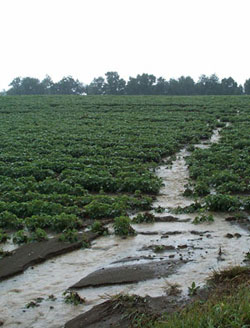Soil Science Society of America
5585 Guilford Road • Madison, WI 53711-5801 • 608-273-8080 • Fax 608-273-2021
www.soils.org
Twitter | Facebook
NEWS RELEASE
Contact: Hanna Jeske, Associate Director of Marketing and Brand Strategy, 608-268-3972, hjeske@sciencesocieties.org
Tillage and reduced-input rotations affect runoff from agricultural fields
June 11, 2013 -- No-till management practices can reduce soil erosion, but evidence suggests they can also lead to increased runoff of dissolved phosphorus from soil surfaces. Meanwhile, farmers looking to avoid herbicides often have to combat weeds with tillage, which causes erosion. With all of the tradeoffs of different management systems, which one should growers use? To answer that question, researchers from the USDA Agricultural Research Service compared nutrient and sediment loss from no-till, conventional tillage, and reduced-input rotation watersheds in a study published online today in Soil Science Society of America Journal.

By keeping a protective layer of plant matter on the soil surface, no-till practices reduce the loss of soil and phosphorus (P) attached to soil particles. But no-till requires herbicides to control weeds, and even after adoption of the practice by many farmers, harmful algal blooms were still occurring in surface waters. It looked as if no-till, while decreasing particulate P loss, was leading to increased runoff of dissolved P.
“Normally when you apply P-containing fertilizers, you would incorporate them into the soil,” says Martin Shipitalo, lead author of the study. “With no-till, you’re just broadcasting it on the soil surface, leading to high P concentrations at the surface. Even if you get less particulate loss, runoff will pick up that dissolved P that’s highly concentrated at the soil surface.”
Shipitalo and his team decided to look at data from a 16-year experiment to compare soil and nutrient runoff in watersheds managed in three different ways – no-till, conventional tillage (chisel-till), and reduced-input rotations. “The idea with the reduced-input rotation was to have a conservation practice that worked for farmers who do not want to use herbicides or large amounts of mineral fertilizers,” explains Shipitalo.
In the current study, researchers provided most of the nutrients to crops in the reduced-input watersheds by planting red clover and spreading manure instead of fertilizers. They minimized the amount of bare soils and used just a shallow disking instead of total inversion tillage to leave some crop residue on the soil surface. While herbicides were used in the experiment, they aren’t necessary because the light tilling and in-row cultivation that was done kept weeds under control.
“Reduced-input rotations strike a medium between conventional tillage and no-till,” says Shipitalo. “And they could easily be adapted to be organic rotations.”
As was expected, the researchers found that soil loss was lowest in no-till watersheds. Reduced-input fields, however, had the highest levels of soil loss. While levels were still below annual soil loss tolerance values, reduced-input practices led to soil loss levels of more than twice those from no-till fields.
To address the concern of dissolved P loss from no-till fields, the researchers compared runoff from conventional tillage and no-till watersheds. While the average loss of total dissolved P from no-till was slightly higher than from conventional tillage, the loss was still quite small. Also, average total P loss from no-till watersheds was actually smaller than that from conventional tillage watersheds.
The lack of large differences in P loss from these two management practices may in part be explained by something unexpected – earthworms. “The biology of the soil changes with long-term no-till,” explains Shipitalo. “By leaving residue cover, you increase organic matter, and you increase earthworm populations.”
But how are earthworms affecting transport of P? Earthworms can ingest and redistribute soil, and they enhance soil structure creating more stable aggregates and allowing water to move more rapidly into the soil. It is also possible that earthworm activity mixes up soil moving surface-applied P deeper into the soil and away from potential runoff.
So which management practice is best for farmers? No-till practices didn’t lead to increased dissolved P runoff in this study, but they require herbicide use. Reduced-input rotations don’t require herbicides, but they led to higher levels of soil loss. The authors suggest further work looking at other reduced-input rotations, perhaps some that use less tillage to tease out even more management options.
“It will depend on the situation and the philosophy of the growers,” says Shipitalo. “There isn’t a one-size-fits-all solution or a certain practice that is best for everyone.”
While there may not be one solution, the increased understanding of the different practices and their tradeoffs provide a basis for farmers to choose a crop management system that is best for them, their crops, and their land.
View the abstract at: http://dx.doi.org/doi:10.2136/sssaj2013.01.0045
To obtain a copy of the complete article, please contact Madeline Fisher at 608-268-3973, mfisher@sciencesocieties.org or Caroline Schneider at 608-268-3976, cschneider@sciencesocieties.org.
The corresponding author, Martin Shipitalo, can be contacted at martin.shipitalo@ars.usda.gov.
# # #
Soil Science Society of America Journal is the flagship journal of the SSSA. It publishes basic and applied soil research in soil chemistry, soil physics, soil pedology, and hydrology in agricultural, forest, wetlands, and urban settings. SSSAJ supports a comprehensive venue for interdisciplinary soil scientists, biogeochemists, and agronomists.